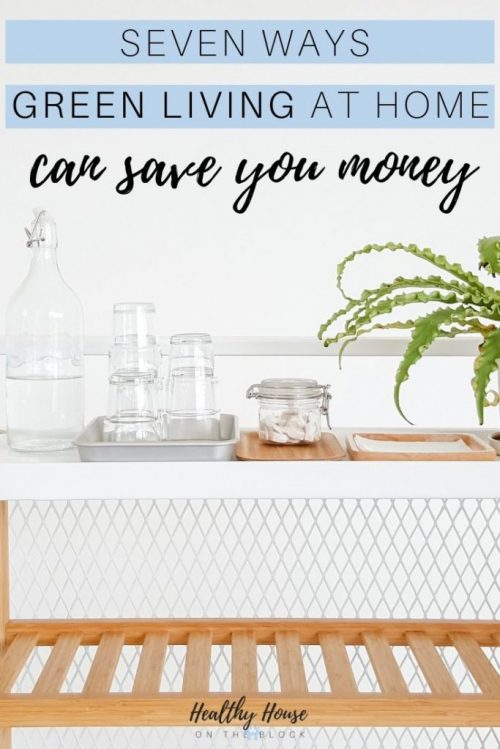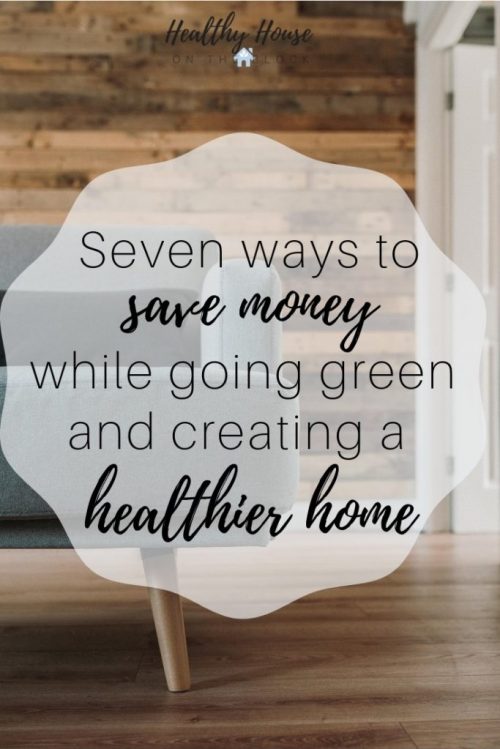
So often we don’t make positive changes because we have excuses. Excuses can be anything from convenience to the cost of making this change. Many times the excuse I hear is that buying healthier products is so much more expensive. I’m here to tell you that making the switch to a greener lifestyle at home has some long term benefits that will save you money in the long run.
Simplifying your life and making your home healthier and safer for your family will end up improving your health as well. By making some small changes that will save you money now and prevent health issues in the future is such a positive change you can make. The ways listed below are incredibly simple changes, but they require changing the mindset you have about your home and environment.
I can’t tell you how great it can be to improve your health, living environment and budget all with a small change.

REMOVING CHEMICAL CLEANERS
Cleaners can end up being quite a hefty charge over the course of a year. If you are a family with small kids, you know this paint point. All the cleaning products around the house add up to a toxin problem and added money spent on all the products.
The best and most cost effective switch I ever made is changing my cleaning routine over to Thieves Concentrated Household Cleaner. It averages out to be about $.04 per ounce (other cleaners are around $.11 per ounce). And the best part is I was able to get rid of almost every one of my cleaners and replace it with this one. I use this product to clean my kitchen, bathroom counters, windows and carpet.
I also made the change of using vinegar, baking soda and tea tree oil in place of toilet bowl cleaner. This is a cleaner I just don’t buy anymore (and it’s one of those expensive ones!).
Another idea is to make your own laundry detergent. You can easily make laundry detergent that costs about $16.00 for 6-12 months worth of laundry. That’s pretty impressive! You can get the recipe I use in my cleaning recipe book on my this page.
STOP USING DISPOSABLE FOOD STORAGE
This is a big one. Could you imagine what you might be able to save if you stopped buying throw away food storage? This could include food storage bags, plastic containers, plastic and paper plates, plastic silverware, straws and anything else you might find in the food storage aisle at grocery stores.
Instead, try to find things you already have that you can use as food storage. One thing we use quite often is glass jars. This can be reused as food storage with no added expense for you. We also use metal containers for lunches so we don’t have to throw away plastic and buy more.
EarthHero has some really great options for switching your kitchen over to non-plastic with food storage options. It’s a great way to help our planet, improve the health of your kitchen and save some money.
KEEP TABS ON SELDOM VISITED SPOTS
When’s the last time you were in your attic or ventured into your crawl space? While many of these places are not necessarily our frequently visited rooms, it’s important to check in on them on a regular basis. By knowing what’s going on in your attic, or knowing if anything is out of place or doesn’t seem quite right, you can save yourself a lot of money in repairs and remodel work. Catching things like moisture intrusion immediately can mean the difference between a repair and a remodel. And knowing if your attic needs additional insulation to protect yourself from things like condensation and heat loss will also end up saving you money.
It’s also important to keep track of yearly tasks in order to ensure your home is free from pests, moisture and other pitfalls.
You can download all of my seasonal checklists on this page to help you remember to check those often forgotten about spaces.
GET MY PASSWORD FOR FREE RESOURCES
My online resource page has guides you can download and print to help you keep your home healthy and safe for your family. Customize them and use them in whatever way works best for your family.

DON’T CLUTTER YOUR HOME WITH STUFF
This is probably one of my best money saving tips, and it really has more to do with your mindset than anything else. So often we see an empty space in our house and we immediately feel the need to fill it up. It can turn into a problem with impulse buys and spending money on things we don’t really need, and may even get rid of in the near future.
Instead, try moving things from a different room to another space in order to make the area feel new and fresh. This is even a great opportunity to repurpose something and find a new use for it.
The goal is to be incredibly intentional about every purchase you make. This will help you start saving and stop spending on things and home goods that you won’t keep around. Changing your habits around shopping can be so beneficial to your financial goals and saving goals.
It also means you have to change your “keeping up with the Jones” mentality and be completely content with what you have and only make purchases you’ve fully thought out. If you need to sleep on the decision to purchase it and make sure it’s not an impulse buy.
UTILIZE PASSIVE ENERGY TECHNIQUES
Passive energy techniques are a really great way to improve your indoor environment and save money at the same time. You help make your home more energy efficient by using natural sunlight and using light blocking practices. You’ll add some life to your cooling and heating systems this way as well as saving on your utility bills.
Basically, the idea behind passive energy techniques is you allow natural light and heat to enter your home in the heating season and you prevent heat and light in the cooling season.
In the heating season, you can leave shades on the southern and western side of your home open to allow ample sunlight inside to warm your home. You can also use shades as an insulator on the north sides of your home or at night.

In the cooling seasons, you want to use your shades to block out heat and light mostly on the South and East sides of your home. If you’re area gets cooler at night you can also open windows in the evening and night hours to allow your home to naturally cool off.
These two practices will help you reduce heating and cooling costs as well as improve the life-span of your appliances.
ADD INDOOR HERBS AND PLANTS
Fresh herbs are a great way to cook inexpensively and naturally at home. When you grow your own and add them to your meals you can save money as well as improve your indoor air. Plants that you have indoors are beneficial to your indoor air as they naturally purify the air at different rates. Some plants purify the air more than other plants and actually reduce toxins inside.
All plants are good for the indoor air in some way. You just want to make sure you don’t overwater plants. This will add excess moisture to your indoor air and can cause an unhealthy indoor environment.
There are so many simple and practically free ways you can start plants from seed at home by using cuttings and seeds from food you’ve already purchased.

-
Rosemary
-
Basil
-
Oregano
-
Coriander
-
Parsley
-
Mint
-
Lemongrass
-
Chives
-
Thyme
USE WHOLE HOUSE FANS
Using your ceiling fans and HVAC fan instead of running your furnace or air conditioning system is another way you can improve your indoor air and increase your savings. With a whole house fan or your HVAC fan, many times you can improve air flow and circulation enough to keep rooms either cooled or heated. If you have a smart thermostat, it can usually detect that this mode should be turned on to increase savings, but if not, you can switch your thermostat to run the fan instead of using heat or cooling.
This option works best in the fall and spring months when temperatures outside can vary greatly.

Using Thieves cleaner will save you a lot of money as it is highly concentrated. It ends up being about $.04/ounce (most cleaners are $.11/ounce). Another way is to avoid cluttering up your home with products you don’t need.
Other ideas include: utilize passive energy techniques, add indoor herbs to garden routine, don’t clutter your house with unnecessary items, and use your HVAC fan to circulate air.






Yes I agree with you completely. Everyone can make a difference to our planet with just a few simple changes at home. Going green can also put more cash in our wallet.
I’m slowly switching all my cleaning products to Young Living and that makes me super excited. And I’m adding to my plants collection as well, woot!
Switching my cleaning products made me so excited too! I’m getting excited for spring and adding a few more houseplants to my collection 🙂
I love this! We are working towards having an eco-friendly home with a focus on cutting out waste and plastics. Thieves cleaner is the best! I find new ways to use it all the time.
Stephanie, that’s awesome! Thieves has SERIOUSLY changed my whole cleaning routine!
I love seeing how people go green! We started a while ago and have yet to further it. There are no excuses. I am getting into the habbit of using non chemicals for cleaning, which is proving to work better
I feel like my plant based cleaners work better too. It’s a long process, but every little bit counts towards the end goal.
Having reusable food baggies is something I never thought about. We go through a ton of baggies in my house! Definitely going to check out this alternative.
Such an interesting reading! I am dealing hard with clutter whenever the new season comes but I think I am doing pretty good with herbs and plants.
Thanks, Helene. Clutter seems to be my biggest battle too! 🙂
I definitely employ all of these green living/saving techniques because they do make common sense to do so. I do re-use containers I get rather than add them to the landfill too.
That’s so great, Elizabeth!
Great tips. So often, living a healthy lifestyle can be expensive – I’m thinking specifically about organic food. It’s nice though that most aspects of green(er) living actually save money. Avoiding disposable items, especially plastic, is my favorite tip.